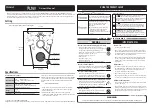
15.2 Troubleshooting
358
The LCD appears
blurred.
Are you pressing the LCD screen too hard?
Press the LCD screen gently. Slight blurring
may occur but this is normal.
AUTO ranging is un-
able to determine a
range.
Is a high-impedance element which is influenced by
noise being measured?
Use guarding.
See (p.A3)
Is an element of other than a capacitor being mea-
sured using the DC bias function?
Turn the DC bias function OFF.
See (p. 58)
A contact error is
generated even
though the connec-
tions are correct.
Is an element of other than a capacitor being mea-
sured using the DC bias function?
Turn the DC bias function OFF.
See (p. 58)
Open compensation
or short compensation
resulted in an error.
Is the open or short compensation wiring correct?
Perform open compensation or short compen-
sation with the proper wiring.
Are you using the instrument in a high-noise environ-
ment?
If you are using the instrument in a high-noise
environment, consider taking the following
measures:
• Use guarding.
• Implement anti-noise measures.
• Separate the sample, measurement cables,
and instrument from the source of the noise
(motor, inverter, electromagnetic switch,
power line, equipment generating sparks,
etc.) or perform the measurement in a sepa-
rate room.
• Plug the instrument into a grounded outlet.
• Use a separate power supply from the
device that is generating the noise.
An error beep sound
is emitted continu-
ously.
Is the measurement value automatic output function
enabled?
When the measurement value automatic out-
put function is enabled, a send error occurs on
the measuring instrument side if the receive
operation is not performed on the PC side, and
a send error sound is emitted continuously
when, for example, there is an internal trigger.
Perform the receive operation on the PC side
and then perform measurement on the mea-
suring instrument side, or disable the measure-
ment value automatic output function.
See LCR Application Disk - Communication Commands
No EXT I/O output sig-
nal can be obtained.
You don't know what type of output circuit is being
used.
The instrument's EXT I/O functionality gener-
ates open collector output. Connect the wiring
properly to the open collector.
See (p. 45)
You are unable to
send and receive
data using RS-232C.
Are you using a straight cable?
Use a cross cable.
Are you using the wrong COM port?
Check whether the computer's settings match
the connected COM port. Connect the cable to
the proper COM port.
Check the computer's settings. The COM port
may be selected at the operating system, driver,
or application level. Check all of these settings.
The computer has no COM port.
Consider using a commercially available USB/
RS-232C conversion cable.
You don't know which command is wrong.
Using an application such as Windows Hyper-
Terminal, check commands using manual input.
The instrument is unable to communicate with the
application.
Check whether the instrument is turned on.
Turn on the instrument and complete any inter-
face connections before launching the comput-
er application.
Symptom
Check Item, or Cause
Remedy and Reference
Summary of Contents for IM3533
Page 2: ......
Page 8: ...Contents vi...
Page 52: ...3 3 When TRANSFORMER Mode 44...
Page 156: ...4 5 Setting Application Settings 148...
Page 200: ...5 3 Application Settings 192...
Page 216: ...6 4 Setting Application Settings 208...
Page 270: ...9 4 Deleting a Panel 262...
Page 316: ...11 7 File and Folder Operations 308...
Page 338: ...12 6 Measurement Using a Computer 330...
Page 396: ...Appendix 13 Device Compliance Statement A26...
Page 399: ......
Page 400: ......
















































